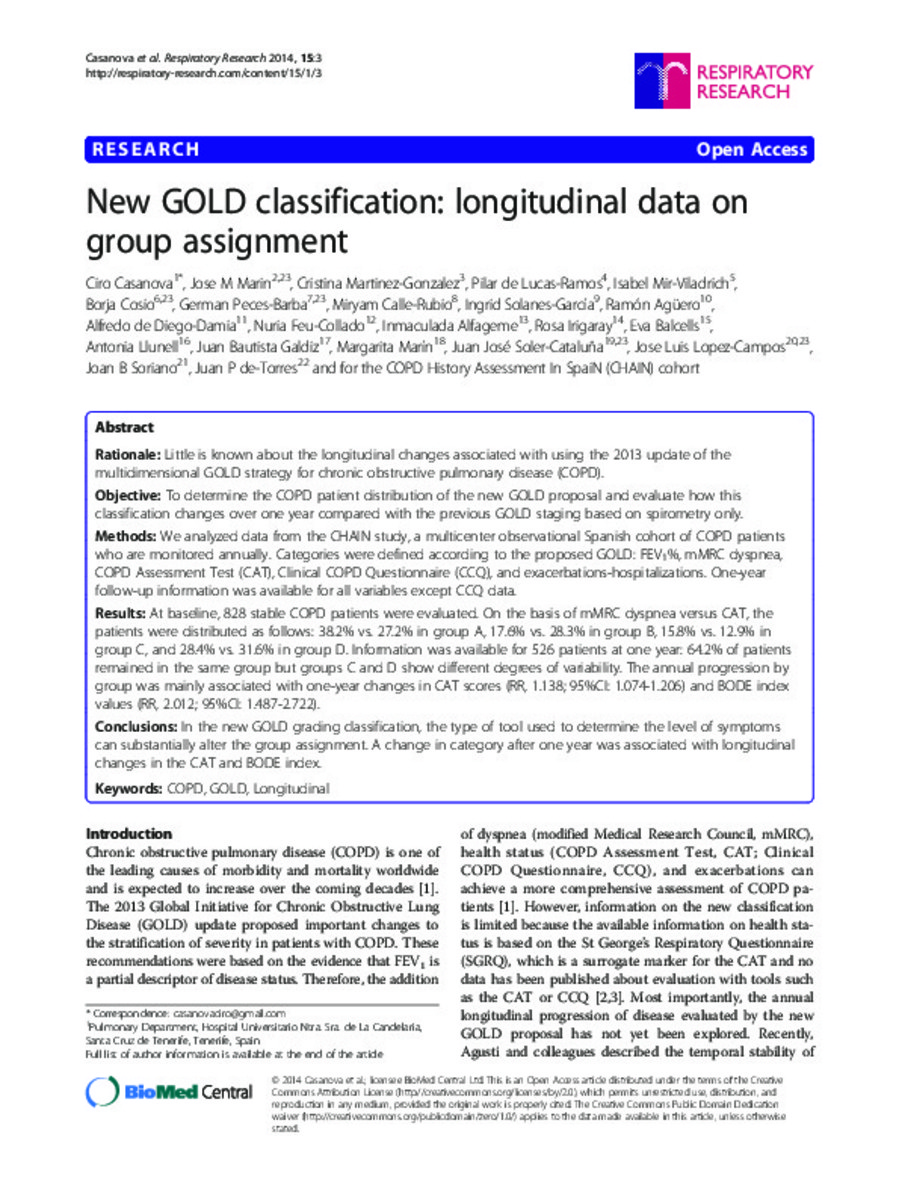Mostrar el registro sencillo del ítem
New GOLD classification: longitudinal data on group assignment
| dc.contributor.author | Casanova, Ciro | |
| dc.contributor.author | Marin, Jose M. | |
| dc.contributor.author | Martinez-Gonzalez, Cristina | |
| dc.contributor.author | Lucas-Ramos, Pilar de | |
| dc.contributor.author | Mir-Viladrich, Isabel | |
| dc.contributor.author | Cosio, Borja | |
| dc.contributor.author | Peces-Barba, Germán | |
| dc.contributor.author | Calle-Rubio, Miryam | |
| dc.contributor.author | Solanes-García, Ingrid | |
| dc.contributor.author | Agüero Balbin, Ramón | |
| dc.contributor.author | de Diego, Alfredo | |
| dc.contributor.author | Feu-Collado, Nuria | |
| dc.contributor.author | Alfageme Michavila, Inmaculada | |
| dc.contributor.author | Irigaray, Rosa | |
| dc.contributor.author | Balcells, Eva | |
| dc.contributor.author | Llunell Casanovas, Antònia | |
| dc.contributor.author | Bautista i García, Joan Damià | |
| dc.contributor.author | Marín Royo, Margarita | |
| dc.contributor.author | Soler-Cataluña, Juan J. | |
| dc.contributor.author | Lopez-Campos, Jose Luis | |
| dc.contributor.author | Soriano, Joan B. | |
| dc.contributor.author | Torres, Juan P. de | |
| dc.contributor.author | COPD History Assessment In SpaiN (CHAIN) cohort | |
| dc.date.accessioned | 2016-09-06T13:17:32Z | |
| dc.date.available | 2016-09-06T13:17:32Z | |
| dc.date.issued | 2014 | |
| dc.identifier.citation | Casanova et al.: New GOLD classification: longitudinal data on group assignment. Respiratory Research 2014 15:3. | ca_CA |
| dc.identifier.issn | 1465-9921 | |
| dc.identifier.issn | 1465-993X | |
| dc.identifier.uri | http://hdl.handle.net/10234/162229 | |
| dc.description.abstract | Rationale: Little is known about the longitudinal changes associated with using the 2013 update of the multidimensional GOLD strategy for chronic obstructive pulmonary disease (COPD). Objective: To determine the COPD patient distribution of the new GOLD proposal and evaluate how this classification changes over one year compared with the previous GOLD staging based on spirometry only. Methods: We analyzed data from the CHAIN study, a multicenter observational Spanish cohort of COPD patients who are monitored annually. Categories were defined according to the proposed GOLD: FEV1%, mMRC dyspnea, COPD Assessment Test (CAT), Clinical COPD Questionnaire (CCQ), and exacerbations-hospitalizations. One-year follow-up information was available for all variables except CCQ data. Results: At baseline, 828 stable COPD patients were evaluated. On the basis of mMRC dyspnea versus CAT, the patients were distributed as follows: 38.2% vs. 27.2% in group A, 17.6% vs. 28.3% in group B, 15.8% vs. 12.9% in group C, and 28.4% vs. 31.6% in group D. Information was available for 526 patients at one year: 64.2% of patients remained in the same group but groups C and D show different degrees of variability. The annual progression by group was mainly associated with one-year changes in CAT scores (RR, 1.138; 95%CI: 1.074-1.206) and BODE index values (RR, 2.012; 95%CI: 1.487-2.722). Conclusions: In the new GOLD grading classification, the type of tool used to determine the level of symptoms can substantially alter the group assignment. A change in category after one year was associated with longitudinal changes in the CAT and BODE index. | ca_CA |
| dc.format.extent | 9 p. | ca_CA |
| dc.format.mimetype | application/pdf | ca_CA |
| dc.language.iso | eng | ca_CA |
| dc.publisher | BioMed Central | ca_CA |
| dc.relation.isPartOf | Respiratory Research (2014), 15:3. | ca_CA |
| dc.rights | © Casanova et al.; licensee BioMed Central Ltd. 2014 This article is published under license to BioMed Central Ltd. This is an Open Access article distributed under the terms of the Creative Commons Attribution License (http://creativecommons.org/licenses/by/2.0), which permits unrestricted use, distribution, and reproduction in any medium, provided the original work is properly cited. The Creative Commons Public Domain Dedication waiver (http://creativecommons.org/publicdomain/zero/1.0/) applies to the data made available in this article, unless otherwise stated. | ca_CA |
| dc.rights | Atribución 4.0 España | * |
| dc.rights.uri | http://creativecommons.org/licenses/by-sa/4.0/ | * |
| dc.subject | COPD | ca_CA |
| dc.subject | GOLD | ca_CA |
| dc.subject | Longitudinal | ca_CA |
| dc.title | New GOLD classification: longitudinal data on group assignment | ca_CA |
| dc.type | info:eu-repo/semantics/article | ca_CA |
| dc.identifier.doi | http://dx.doi.org/10.1186/1465-9921-15-3 | |
| dc.rights.accessRights | info:eu-repo/semantics/openAccess | ca_CA |
| dc.relation.publisherVersion | https://respiratory-research.biomedcentral.com/articles/10.1186/1465-9921-15-3 | ca_CA |
| dc.type.version | info:eu-repo/semantics/publishedVersion |
Ficheros en el ítem
Este ítem aparece en la(s) siguiente(s) colección(ones)
-
MED_Articles [646]
Articles de publicacions periòdiques
Excepto si se señala otra cosa, la licencia del ítem se describe como: © Casanova et al.; licensee BioMed Central Ltd. 2014
This article is published under license to BioMed Central Ltd. This is an Open Access article distributed under the terms of the Creative Commons Attribution License (http://creativecommons.org/licenses/by/2.0), which permits unrestricted use, distribution, and reproduction in any medium, provided the original work is properly cited. The Creative Commons Public Domain Dedication waiver (http://creativecommons.org/publicdomain/zero/1.0/) applies to the data made available in this article, unless otherwise stated.








